Located in the Godavari region of the Eastern Ghats of Andhra Pradesh, Papikonda National Park is one of the most beautiful places in South India, rich in various fauna. The park’s total area is about 1,012.86 square kilometers, and it mainly falls under the Alluri Sitarama Raju and Eluru districts of Andhra Pradesh, with some areas extending up to Telangana. The park’s wide variety of flora and fauna attracts tourists, eco-tourists, wildlife photographers, and environmentalists alike.
This is also an important watershed of the Godavari River. The Godavari River which flows through Papikonda National Park’s forests and hills forms natural embankments and sandbars, creating crucial habitats for riparian and riverine birds. Papikonda was established as a Wildlife Sanctuary in 1978 and was notified as a national park on 4, November 2008.
Key Facts:
- Located in Andhra Pradesh and Telangana
- Area: 1012.86 sq. km.
- Established: in1978 (as a wildlife sanctuary) and in 2008 (national park)
- Peak tourism seasons: November to February
- Key features: Godavari River, rich biodiversity, and tropical forests are notable.
- A three-day survey by the IISER-Tirupati between March 14 and 18, 2024 covered over 200 species.
Why Visit Papikonda National Park?
Papikonda National Park is famous for its rich floristic biodiversity with over 2531 species under 700 genera and 125 families, accounting for about 13% of the total Angiosperms in the country. The park contains about 31 species of plants that are called to be threatened as seen in the red data book registered on the ENVIS website. The park also has a rich agro-biodiversity with 96 species that are the wild relatives of crops.
The visitors may find themselves surrounded by lush green forests, undulating hills, and the vast Godavari River passing through the park. The national park acts as a refuge for several endangered species like the Indian leopard, Indian pangolin, and the magnificent King Cobra. Even birdwatchers may be pleased to see more than 200 species of birds like the Indian pitta and Malabar trogon.
The other aspect of the park that makes it more attractive is the rich culture found in the area, with Konda Reddy and Koya tribes being the major residents of the villages around the park. Their close and protective bond with nature encourages many age-old and interesting practices worthy of sharing with tourists.
Importance of Historical Perspective
The chronology of events surrounding the Papikonda National Park traces back to ancient times. The area was also under the Kakatiya Empire and within the park’s boundaries, several historical places are still found. The park derives its name from Papikonda Hill which is one of the hills in the region.
Best Time to Visit Papikonda National Park
Papikonda National Park can be best visited in the cooler months which are from November to February. As during this time, the temperatures are moderate, there is plenty of activity from the wildlife and the vegetation within the parks is very thick and green. Summer months may be very hot and dry with temperatures going as high as 40 degrees Celsius while the pattern reversal, the monsoon, which lasts from June to September experiences very heavy rains that render most parts of the park inaccessible.
Seasonal Assessment:
- Winter (November to February): Best for safaris and treks as the weather is cool and comfortable and wildlife sighting chances are high.
- Summer (March to May): Hot and arid but suitable for viewing animals around waterholes.
- Monsoon (June to September): The period of rain makes trekking activities challenging; however, the park gets very green ideal for leisure drives and boat rides.
Entry Fees and Park Timings
The park is accessible throughout the year, but certain areas may close due to weather conditions, especially during the monsoon.
Entry Fees:
- Indian Nationals: ₹50 per person
- Foreign Nationals: ₹500 per person
- Vehicle Entry: ₹200 for personal vehicles
- Camera Fees: ₹200 for still cameras, ₹500 for video cameras
Timings:
- Opening Hours: 6:00 AM to 6:00 PM daily
- Safari Timings: Morning safaris typically run from 6:30 AM to 9:30 AM, and afternoon safaris from 3:30 PM to 6:30 PM.
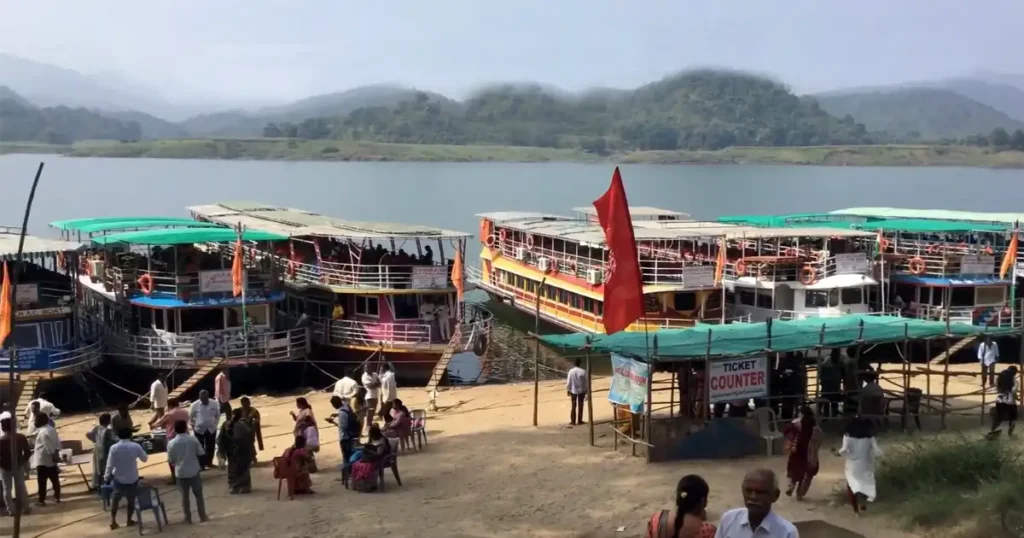
Geography and Topography of Papikonda National Park
1. Geography:
Geographically Papikonda National Park lies between 16°57ʹ0˝–16°55ʹ0˝N and 82°15ʹ0˝–81°20ʹ0˝E. It spans the East and West Godavari districts in Andhra Pradesh and a portion of Telangana’s Khammam district (now partly merged with Andhra Pradesh). Situated along the Godavari River in the Eastern Ghats, encompassing the Papi hill range starting from Koida and Kotarigommu to Singanapally and Devipatnam, flows in a length of 42.5 km. The park’s terrain is mostly hilly, with some plains, and an average elevation of 600 m, and features glens and gorges with flowing streams.
The park is divided into three forest divisions (Eluru, Kakinada, Rajahmundry), 6 forest ranges, and 30 forest beats. The forest beats are given here:
| Forest Division | Forest Range | Forest Beats |
| Eluru, Kakinada, Rajahmundry | Rampachodavaram | Valamuru, Pindikura Valasa |
| Gokavaram | Kondamodalu, Teliperu, Katchuluru, Pedanunthala, Manturu, Devipatnam | |
| Polavaram | Sirivaka, Shivagiri, Chilukaluru, Tekuru, Thutigunta, Kondrukota, Udtapally, Netteppakota, Kothuru | |
| Kukunoor | Pentapally, Tekupalli, Koida, Kakeshnur, Chigurumamidi, Kavadiguntla East, Kavadiguntla North | |
| V.R. Puram | Pocharam, Thummileru, Geediguppa, Darapally, Maredupudi, Gonduru, Buruguwada | |
| Chinturu | Eruwada, Gulletiwada |
2. Geological Composition:
- Rocks: The area is rich in metamorphic rocks, including granite, graphite, and gneisses. Other notable formations include ferruginous quartzites, banded magnetite, and quartz.
- Soil Types: A diverse soil profile characterizes the area, featuring lateritic, alluvial, loamy, and black soils.
3. Climate and Terrain Overview:
- Climate: The region experiences a tropical climate, with warm temperatures and seasonal rains.
- Terrain: The landscape is notably sloped, ranging between 30% to 50% in steepness, adding to its unique geographic character.
4. Climate Details:
- Rainfall: Annual precipitation falls between 934 mm to 1,375 mm.
- Temperature: The temperature ranges from a mild 17°C to a warm 37°C, with occasional peaks reaching up to 48°C.
5. Water Sources: Papikonda National Park is connected by a network of Rivers, Vagus, Rivulets, and Tributaries. The main water resources are River Godavari, Yerra Kalva, Pamuleru, Ijjaluru Vagu, Kovvada Kalva, Seethapally Vagu, Katchuluru Vagu, Jalthar Kalva, Peddavagu, and Chigurumamidi Vagu. Etc.
6. Ecological Highlights:
- Keystone Species: The Indian Gaur holds significant importance within the local ecosystem as a keystone species.
7.Land Coverage and Conservation Areas:
- Submergence Area (Indira Sagar/Polavaram Project): Parts of this region fall within the submergence area for the Indira Sagar Project, also known as the Polavaram Project.
- Reserved Forests: Approximately 1.48 square kilometers (148.38 hectares) of this land is designated as reserved forest area.
- Non-Forest Land: Around 15.53 square kilometers (1,553 hectares) consist of non-forest land.
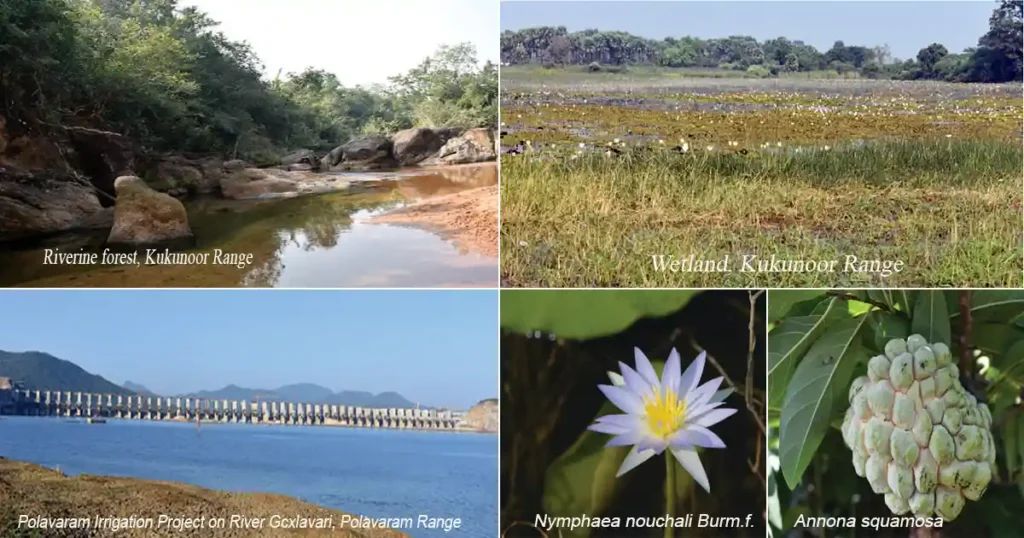
Tribal Communities of Papikonda National Park
Several tribal communities live around Papikonda National Park, including Gonds, Koyas, Koya Doras, Toti, Dadve, Kondas, Raj Gonds, Pradhan, Gowari, and Kolam. The Gonds are the largest group, and all these communities rely on forest resources, passing down traditional plant knowledge through generations.
1. Koyas
The Koyas, a part of the larger Gond tribe, speak a simple form of Telugu and are primarily farmers. In summer, they gather timber, bamboo, and other forest products. This season is festive for them; they drink sap from the sago palm, celebrating with dance and community gatherings. Their bond with the forest is essential for both food and income.
2. Konda Reddis:
The Konda Reddis, who live along the Godavari River, are shifting cultivators, gathering roots, leaves, and wild fruits. They sell items like tamarind, adda leaves, and broomsticks, and grow jowar, ragi, and other crops. They worship local deities and celebrate various festivals. Community issues are managed by a council, led by a village head, Pedda Kapu.
The Konda Reddi tribe, a Particularly Vulnerable Tribal Group inhabiting the Papikonda hill range in the Godavari region, claimed that the Indian laurel tree stores water, especially in summer. This was confirmed on March 30, 2024, when Andhra Pradesh Forest Department officials cut the bark of an Indian laurel tree in Papikonda National Park, Rampa Agency, Alluri Sitharama Raju district, and found it indeed stores water.

Flora and Fauna: Wildlife of Papikonda National Park
Flora:
The tropical mixed forests of this park consist of multiple teak species, bamboo, and certain uncommon medicinal plants. These types of forests also have a lot of vegetation supporting many types of animals.
Key Plant Species:
- Moist mixed deciduous forests, (3B/C2)
- Dry mixed deciduous forests, (5A/C3)
- Thorny scrub forests, (6A/DS1)
- Hill-top flora, (5A/DS2)
- Riverine Forest
1.Moist mixed deciduous forests: Typically found in moist valleys and perennial stream courses at altitudes ranging from 500-1000 m with moist soils. In the Maredumilli region, where also observed in Valamuru, Bodhaluru, PK Valasa and Ijjaluru, the critical species composition includes Xylia xylocarpa, Adina cordifolia, Diospyros sylvatica and Syzygium cumini.
2.Dry Mixed deciduous forest: This type of forest occupies about 60-70% of the National Park composed of a closed upper stratum of tall deciduous trees extending up to 20 meters in height. This includes understorey trees and shrubs and climbers whilst a few of the semi-evergreen species occur in wetter conditions.
Common Tree Species: Terminalia alata, Anogeissus latifolia, Adina cordifolia, and Pterocarpus marsupium, species like Cleistanthus collinus, Holarrhena pubescens, and Dillenia pentagyna are of considerable importance.
3.Thorny Scrub Vegetation: Thorny scrub vegetation refers to the modified forest types that exist in the flat or gently rolling plateaus and low hills bordering dry deciduous forests. These forests support stunted, thorny hardwood tree species, with tree heights ranging from 5-10 meters; there are indications of a low irregular canopy cover caused by interference of the trees resulting in thickets of trees measuring 4-6 meters.
- Common Tree Species: Senegalia chundra, Diospyros melanoxylon, Strychnos nux-vomica.
- Shrubs: Bridelia Montana
- Climbers: Abrus precatorius
- Herbs: Boerhaavia diffusa, Vernonia cinerea
- Borassus flabellifer low-lying palmyra trees with scanty Acanthospermum hispidum herbs.
- Common Locations: Chilugaluru, Tekuru (Polavaram range) Chigurumamidi, Tekupally, Koida, Kavadiguntla East, Pentapally, Kakeshnur (Kukunur range), Gulletiwada (Chinturu range).
4.Hilltop Grasslands: In places like Papikonda, Kondamodalu, and Valamuru hilltop grasslands can be seen above 800 m altitude. These open grasslands are dotted with a few stunted trees such as Terminalia chebula, Gardenia latifolia, and Diospyros melanoxylon. The grasses found growing in these areas include Iseilema laxum, Ischaemum indicum, and Echinochloa colonum.
5.Riverine Forest: Riverine forests are found in clusters on all the streams and nalas running within and around the Godavari River. Much of the vegetation is represented by Dimorphocalyx glabellus, Ficus nervosa, Gnetum ula, Homonoia retusa, Melastoma malabathricum, and Terminalia arjuna.
The herbaceous flora also comprises Musa ornata and Ensete glaucum which occur along the stream banks at altitudes over 700m.
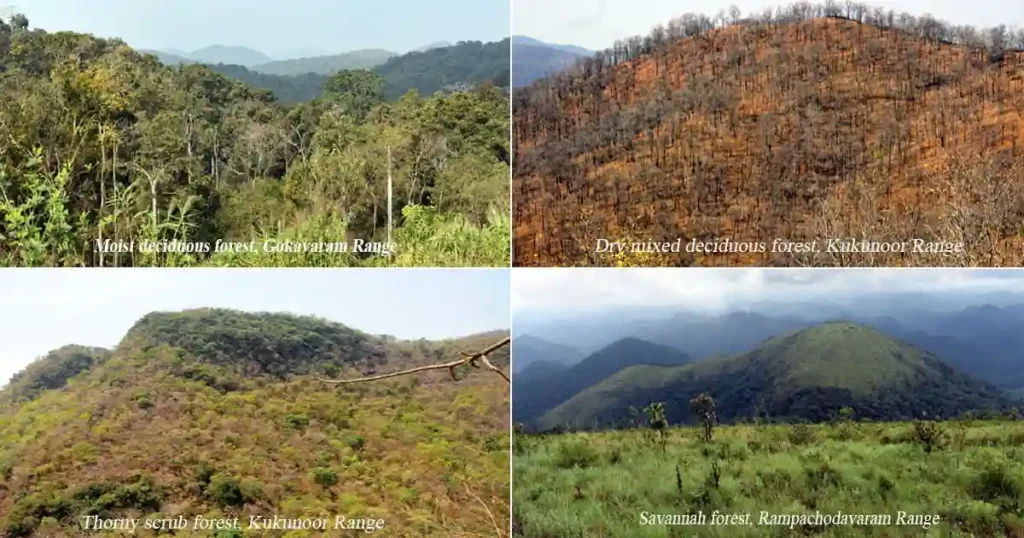
Fauna:
Papikonda National Park is known for its diverse range of species, especially large mammals and birds. Some of the most prominent wildlife include:
1.Mammals:
- Kanchu Mekha Goat: A unique dwarf breed of goat, native to this region and locally known as the “kanchu mekha.
- Tiger: The apex predator of the park, typically found in dense forest areas, the Godavari River ecosystem, and Gudisa Grassland.
- Indian Leopard: One of the top predators in the park, often spotted during wildlife safaris.
- Sloth Bear: A key species that thrives in the park’s dense forests.
- Indian Bison (Gaur): The largest bovine species found in the park.
- Wild Boar, Spotted Deer, and Sambar Deer: Commonly seen grazing near water sources.
- Indian Bison (Gaur): The largest bovine species found in the park.
- Hyena: A skilled scavenger, the hyena is an important part of the park’s ecosystem, often heard through its distinctive calls at dusk.
- Langurs and Macaques: Langurs live in forests; macaques near water. Both are social and adaptable.

2.Birds:
A three-day survey in March 2024 recorded over 200 bird species across the 1,012 sq. km Papikonda National Park (PNP) in Andhra Pradesh. Led by the Andhra Pradesh Forest Department and IISER-Tirupati, the survey covered dense tiger habitats, the Godavari River ecosystem, and Gudisa Grassland—the state’s only grassland. A highlight was the endangered Black-bellied Tern spotted along the Godavari.
- Indian Pitta: A colourful bird that migrates seasonally to the park.
- Malabar Pied Hornbill: A birdwatcher’s delight, often spotted in the higher canopies.
- Grey-headed Fish Eagle: Often seen near the Godavari River.
- Common Peacock: A highly adorned and large bird that is seen fanning its tail in other parts of the park.
- Red Jungle Fowl: The wild father of the domestic chicken, usually seen scratching for food in the undergrowth.
- Kites, Owls, Hornbills, and Singing Birds: Kites and owls are in the park contributing to the diversity of raptors. Hornbills and vivid songbirds on the other hand brighten the life and add colour to the stratum of trees and vegetation.
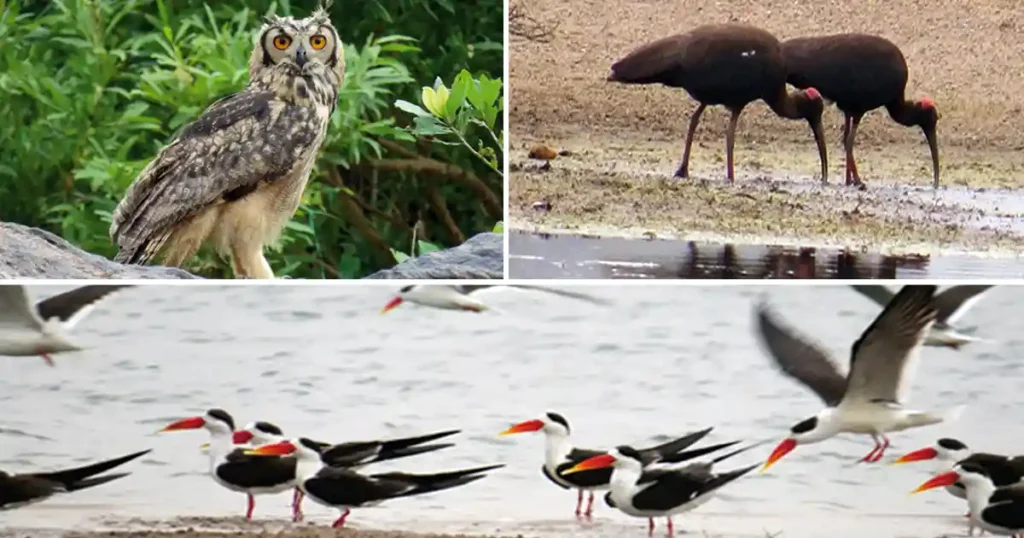
3. Reptiles and Amphibians: Many species of snakes, including the Indian Python and the King Cobra, turtles, lizards, and frogs are also found in Papikonda.
5. Butterfly:
A butterfly survey conducted from 12 to 15 December 2019 in Papikonda National Park by Warblers and Waders (a platform established on 1 January 1990 for bird watchers and nature lovers) recorded 21 new species of butterflies, registering a total of 136 butterfly species in the park. Some of the rare butterflies that exist are the Great Swift, Large Snow flat, Yellow Jack Cellar, Plain Palm Dart, and Banded Blue Pierrot.
5. Dragonflies and damselflies:
The survey recorded 54 species of dragonflies and damflies. The list of butterfly species seen includes 31 species of the family Skimmers, 11 species of Marsh darts, 3 species of Glories, 2 species of Stream Jewels and Club Tails, and 1 species of Lestidae.
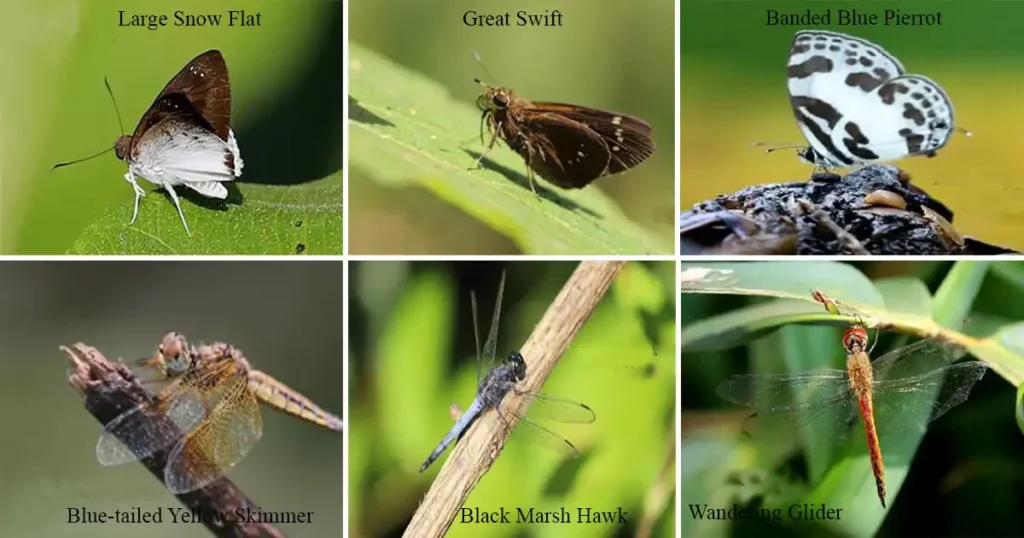
Safaris and Activities in Papikonda National Park
There are many beautiful attractions in Papikonda National Park, and the major activities for nature and adventure enthusiasts – such as wildlife safaris, trekking, river safaris on the Godavari River, bird watching, and the beautiful waterfall Savatula Gundam Waterfall. Here are a few details about each one, along with the fees and additional information.
1. Wildlife Safari and Trekking:
Papikonda National Park organizes guided jungle safaris and trekking options through which visitors can venture deep into the forests of the area. It has many varieties of wildlife such as Indian leopard, sloth bear, four-horned antelope, and rarely seen birds. The most common mode of exploring the park is through jeep safari. Usually, the entry fee to the parks is ₹10 to ₹50 per person. Jeep safaris cost ₹1000 to ₹2000 per person depending upon the size of the group and season.
Papikonda is home to many dense forests that provide treks to adventure seekers. There are different types of treks, and guided treks can give more meaning to the trek by knowing and exploring the flora and fauna around it. Some of the treks lead through dense forest areas up to hill tops providing sceneries on river banks and the nearby forest area.
2.Godavari River Safari:
The Godavari River flows through Papikonda National Park and can be explored by boat safari, which is an alternative to viewing the wildlife and the scenic riverbanks. The boats usually start from Rajahmundry. However, the charge for enjoying the boat services ranges between ₹300 to ₹1000 per head according to the timeframe and the kind of service. Observing wildlife through the water is perhaps the most calming and distinctive experience one can ever have.
3. Savatula Gundam Waterfall:
This is a lovely place within the park. There is no direct entry fee for visiting the waterfall, though it is generally accessed in the course of a more comprehensive trekking or jeep safari tour. The place is a haven of tranquillity amidst greenery, and it’s a common spot for photography and rest.
4. Birdwatching:
It’s a haven for bird lovers as species such as Malabar trogon, Indian pitta, and varieties of hornbills and eagles exist. However, there is no other fee besides the entry fees into the park; although for about ₹500 to ₹1000, you could be guided to view some of these species.
5. Nearby Places of Interest
- Papi Hills: Located at the confluence of the Godavari River, these hills are perfect for breathtaking scenery, boat rides, and camping.
- Rajahmundry: A city on the way to Papikonda National Park, which is characterized by interesting cultural landmarks.
- Bhadrachalam Temple: This is a very popular pilgrimage site which is located about 70 km from the park and is dedicated to Lord Rama.
Note on Papikonda National Park in UPSC and Other General Knowledge
Paper Papikonda National Park is often seen in discussion and has been emphasized in many examinations as it carries vast bio-geographical importance and has been under conservation. The park belongs to the Eastern Ghats, which is one of the major biodiversity zones. It contributes significantly to the conservation of endangered animals such as King Cobra, Indian Pangolin, etc.
Accommodation Facilities in Papikonda National Park
Accommodation facilities are sparse inside the park and near the park but towns like Rajahmundry and Bhadrachalam have a wide range of accommodations from budget-friendly guesthouses to luxury resorts.
1. Popular Hotels and Resorts:
- Haritha Hotel: An eco-friendly accommodation provided by Andhra Pradesh Tourism.
- Rajahmundry Eco Resorts: A luxurious resort overlooking the Godavari River.
2. Camping:
For those looking for more of an experience, it is possible to camp in the vicinity of the park. It is however advisable on the other hand to seek counsel from appropriate authorities regarding permit acquisition as well as what is required for safety.

How to Reach Papikonda National Park
Papikonda can be reached by air, rail, and road; transport is easily accessible in the adjoining cities.
By Air: The nearest airport is Rajahmundry Airport, located around 50 kilometers from the park. Domestic flights from major Indian cities, including Hyderabad, Bangalore, and Chennai, frequently land here.
By Rail:
The closest railway station is Rajahmundry Railway Station, well-connected to various parts of India via express trains.
By Road:
Papikonda is well connected to major cities in Andhra Pradesh by road. National highways connect Rajahmundry to the park, and buses or taxis can be arranged for transport.
Conclusion
Papikonda National Park has a wonderful combination of natural and biological characteristics along with ecological significance, thus making it a constant attraction for all nature and wildlife lovers. The placid sights, primarily the Godavari River and the dense greens of the Eastern Ghats nurture a wide variety of flora and fauna, including the likes of the Indian Leopard and many birds as well which are inclusive of the endangered species. November to February is the best time to visit the park since the climate is pleasant and a lot of wildlife can be easily spotted.
Whether it is the wildlife safaris you want to take boat rides and trekking, or simply pampering your senses with nature; Papikonda National Park ensures satisfaction.
Useful Links:
- Official Andhra Pradesh Tourism Website: Visit here
- Papikonda National Park Overview: Wikipedia Page
FAQs About Papikonda National Park
Q:What is Papikonda National Park famous for?
A: The park is famous for its diversity of flora and fauna with animals such as the Indian Leopard, Gaur, and many species of birds, among others. The Park also has great geographical significance concerning the Godavari River.
Q: What is the best time to visit Papikonda National Park?
A: The best season to visit is between November to February, as the temperature is low and wildlife is observed in full swing.
Q: Which river flows through Papikonda National Park?
A: Rivers within Papikonda National Park include the Godavari River, which is skirted by forested hills, creating natural barriers and sand deposits that form critical areas for the habitation of margins and riverine birds.
Q: Where is Papikonda National Park located?
A: Papikonda National Park is located in the East and West Godavari districts of Andhra Pradesh, India.
Q: What animals can be found in Papikonda National Park?
A: The park is home to several species, including the Indian leopard, dhole, Indian pangolin, and various birds and reptiles.
Q: Are there accommodation options near Papikonda National Park?
A: Yes, there are various hotels and resorts available in nearby towns like Rajahmundry and Bhadrachalam, offering comfortable lodging options for tourists.
You May Also Like





2 thoughts on “Papikonda National Park”